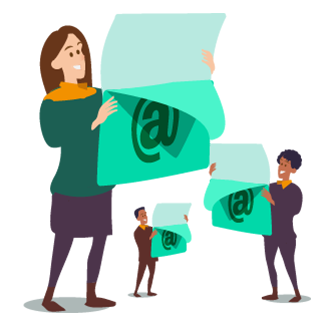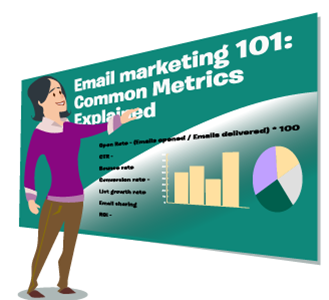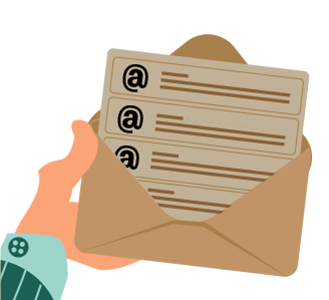In marketing, customer retention is the ability of a business to retain customers.
It is both a measure of customer loyalty and the capacity of the business to keep customers satisfied by giving them products or services that pleases them.
However, what happens after a prospect becomes a customer is rarely talked about.
Sometimes, businesses think that they should prioritize acquiring new customers instead of focusing on previous ones. This can be a big mistake.
Think of marketing as a funnel where you attract a wide net of people to your website and slowly incentivize them to become more interested in your offerings.
With this model in mind, marketing represents only the beginning of the funnel, the “top of the funnel” as it’s known.
There’s something more critical that happens at the end of the funnel (i.e., after someone makes a purchase).
When it is done right, can help you increase your revenue substantially.
It’s called retention.
Because in any business, the best customer is the one that comes back for more. A returning customer is cheaper for the company to hang on to than to acquire a new one.
Also, a happy customer will also tell the people around him about your business through word-of-mouth, becoming a loyal ambassador for your brand.
How can email help you retain clients?
Top-of-mind positioning
On average, a customer has a 27 percent chance of buying from you again. If they make a second and third purchase, they have a 54 percent chance of making another purchase.
This means that the longer a customer sticks around; the more profit you are getting from them. Because costs of converting them to buy from you again go way down. This is especially true for e-commerce businesses.
However, to maximise the lifetime profit of your customer, you’ll need to retain, upsell, and cross-sell your customers.
In a world where attention spans are getting shorter, and distractions are getting stronger, you need to stay top-of-mind of your customers.
Email is a powerful tool to nurture leads, especially existing customers. And email is still the top way in which most people would like to be reached.
Referrals lower acquisitions costs
Each time a customer makes a purchase, he or she becomes more comfortable with you. He or she is therefore more willing to refer you onto someone else.
Studies show that customers are more 50% more likely to make referrals to more people, than a one-time purchaser after 10 purchases.
When repeat customers start becoming your walking brand ambassadors, your revenue is going to go through the roof.
It’s nearly free marketing — the only cost is retention.
The key to retaining your customers is to make them feel like they are part of a community – in this case, it’s your brand’s family.
Through timely email messages to your customers with relevant content, you’re continuing to build your significance and authority in their lives.
You’ll make more sales and be the first product or service that comes to mind when a real-life friend or family member asks for a recommendation.
Customers make great data points
If you want to learn how to convert your prospects, look no further than your current customers.
The fact that they are willing to invest time and money in your business in the first place tells you that you did something right.
Through a long-term relationship you can get to know them better, and vice versa. You’re no longer just building leads, but friendships too.
With emails, you can encourage feedback to gather data on your customers, and tweak the customer experience for new buyers.
Email Strategies for Customer Retention
A good email retention strategy can do wonders for your marketing efforts. After all, It’s no secret that email marketing is the most effective marketing channel with a 4400% ROI.
Here are 5 of the best email strategies you can use to retain more customers and build a strong, loyal following.
Segment your email readers
You’ll often hear about segmentation when it comes to email marketing.
In a nutshell, email segmentation means splitting your email subscribers based on their actions.
For example, you have 2 products for sale. Some customers bought either product A or B, but there are some that purchased both A and B.
This tells you that those that bought A and B are likely to buy again from you, and you should focus more attention on them.
This is just one of the countless way you can segment your list. Segmenting your email list allows you to retain customers since you are more likely to send the right emails at the right time.
When you are sending emails that are too generic and not relevantly based on the customer’s interaction, they are much less likely to be engaged.
For example, if you ‘ve stayed at a hotel in Paris, but I’ve received an email asking me ‘How was your stay in Europe?’, you’re more likely to ignore this email or other future communications because they are not relevant.
This is why segmentation is so vital to customer retention. If you send bulk emails to your entire email list without targeting specific segments, you’ll end up with a massive unsubscribe rate.
Segmenting based on the previous actions of your subscribers and customers is a much better way to retain them, and keep them interested.
Send friendly reminders
Sending friendly reminders over email are necessary if you want to retain customers, especially if your products are continuity based, such as subscription services.
For example, if a customer’s credit card is expiring soon, you can email them a sequence of emails reminding them to update their particulars, so their service doesn’t get disrupted.
The trouble is, many companies don’t know how to use automated email effectively to encourage repeat purchases.
There’s significant upside to adopting email marketing. It generates the highest return on investment (ROI) compared to other conventional digital channels, earning businesses an average of $38 for every dollar invested, according to a VentureBeat Insight study.
It also cites that “84% of marketers believe email is important or critically important for customer loyalty.”
For e-commerce web stores, a useful email sequence to help increase retention is the use of abandoned cart sequences.
An abandoned cart sequence refers to a set of autoresponder emails that get sent out automatically when a registered customer leaves the web store without paying for their items.
Perhaps they’ve changed their minds, or they’ve forgotten because life got in the way.
In any case, these are red hot leads because they are customers who already bought from you, and they were almost ready to buy, but something prevented them to.
The job of the abandoned cart sequence is to nudge them back to their site and complete their transaction.
Abandoned cart emails are a necessity for any e-commerce store who wants to lower their cart abandonment rate and increase revenue.
Remember to include a picture of the product if possible, and a clearly visible link back to the shopping cart so customers can complete their purchase.
You can also use a discount code as a carrot to entice customers back to completing the transaction.
If you don’t know what people’s objections are, you’ll want to ask. Add a question to your first email that solicits feedback about why they didn’t complete the purchase.
When sending reminder emails, it is always good to send them in a sequence instead of a single email.
Reward customers for their loyalty
Customers are the foundation of any business, so it is crucial that you reward them appropriately.
You don’t need to set aside a fortune to shower them with gifts. After all, running a business means you need to watch your bottom line, and you can’t just give things away for free.
However, you can give them a little something on special occasions.
Special occasions don’t necessarily have to be Valentine’s Day, Father’s day, Christmas, and so on.
These, again, are generic, and if you want to retain your customers, you need to make them feel something.
One way of celebrating unique occasions is to send a small gift on customer’s birthdays.
Birthday discounts work not just because they make customers feel appreciated, they encourage customers to spend more on their special day too.
Showing your appreciation by making customers and subscribers feel special is a bullet-proof retention strategy.
Another way to reward customers is to celebrate anniversaries.
Keep track of how long the customer has stayed with your business. Send them a little something over email when they’ve been subscribed to your newsletter or loyalty club for a year, letting them know that you remember.
You can also encourage other types of engagement such as reviewing products or send them a small gift, or you can give them an overview of their purchases or progress with your product during the past year.
Doing this creates a feeling of progression for your customers as they can feel that they are growing together with your business.
Also, if your business has a loyalty program, you should remember to reward customers accordingly.
Once a year you can show them an overview of what they’ve purchased, and then show them what that has earned them.
Perhaps they get a gift card with an amount based on how much they’ve purchased during the year.
Or maybe, you have a loyalty program where people earn points they can use towards discounts on new products.
Whatever your loyalty program is, remind customers why they joined your club, and give them an incentive to stay in the club.
Create a testimonial drive
Reviews and customer testimonials can be beneficial for your business in many ways.
Not only do testimonials provide useful insights on your products and services, but it also helps future prospects make more informed decisions about your business too.
Testimonials are especially useful for big-ticket products or services that require a long-term commitment. Positive reviews can create the final push that moves prospects.
Therefore, it is crucial that you collect as much reviews and testimonials as you can from your customers. Remember, you can never have too many testimonials.
Sending targeted email series to users is the easiest and cheapest way to collect a ton of testimonials.
You can either send emails to encourage customers to go back to your site and leave a review, or you can ask them to write a testimonial that you can use on your website.
As a rule of thumb, you should give customers about a week to try it, and then send them an email asking them what they thought of the product.
Even if they only have negative things to say, and likely won’t return to buy again, you can use this information to improve and make your products, website, and so on even better.
Sending this type of emails reminds the customer where they made the purchase and creates top-of-mind awareness.
If you stay top of mind in people’s head, chances are they will return to you the next time they need a similar product.
Reach out to your customers
Unlike social media, emails are a highly personal form of communication.
Like a well-penned heartfelt letter, the most effective emails are the ones that can stir up emotions of the reader.
So, how do you make customers and subscribers feel good about themselves?
Write them an email, and tell them how awesome they are.
For example, if you are selling a service (such as a teaching course), congratulate them when they have achieved a milestone.
Perhaps they have finished their first module or completed their 10th assignment. Tell your customer how great they are and encourage them to soldier on.
It reminds customers of their progress and the results that our product gives them, and as long as people are seeing great results, they’re unlikely to leave.
This tactic doesn’t just apply to the teaching business. It’s just as useful for e-commerce or SaaS business models.
For example, if you run an online makeup store that only is against animal testing, you can send an email to your customers and thank them for contributing to the fight against animal cruelty.
Make your customers feel that they are part of a greater cause to grow loyalty towards your business.
It’s all about your customers’ feelings
Email retention marketing isn’t about creating a great sales pitch. It’s making your customers know that they are special and appreciated.
Not all retention emails work for everyone, so make sure you test different emails to see which works best for your audience.
At the end of the day, it’s about understanding what your customers want, because coming up







